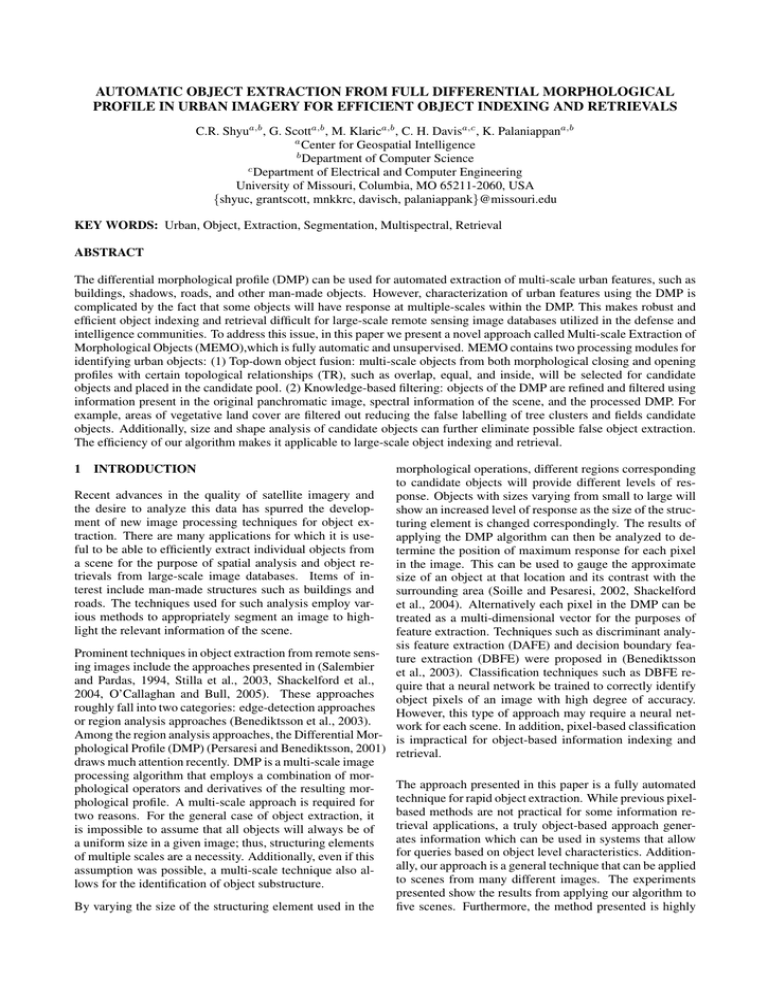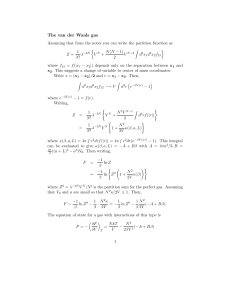AUTOMATIC OBJECT EXTRACTION FROM FULL DIFFERENTIAL MORPHOLOGICAL
advertisement

AUTOMATIC OBJECT EXTRACTION FROM FULL DIFFERENTIAL MORPHOLOGICAL
PROFILE IN URBAN IMAGERY FOR EFFICIENT OBJECT INDEXING AND RETRIEVALS
C.R. Shyua,b , G. Scotta,b , M. Klarica,b , C. H. Davisa,c , K. Palaniappana,b
a
Center for Geospatial Intelligence
b
Department of Computer Science
c
Department of Electrical and Computer Engineering
University of Missouri, Columbia, MO 65211-2060, USA
{shyuc, grantscott, mnkkrc, davisch, palaniappank}@missouri.edu
KEY WORDS: Urban, Object, Extraction, Segmentation, Multispectral, Retrieval
ABSTRACT
The differential morphological profile (DMP) can be used for automated extraction of multi-scale urban features, such as
buildings, shadows, roads, and other man-made objects. However, characterization of urban features using the DMP is
complicated by the fact that some objects will have response at multiple-scales within the DMP. This makes robust and
efficient object indexing and retrieval difficult for large-scale remote sensing image databases utilized in the defense and
intelligence communities. To address this issue, in this paper we present a novel approach called Multi-scale Extraction of
Morphological Objects (MEMO),which is fully automatic and unsupervised. MEMO contains two processing modules for
identifying urban objects: (1) Top-down object fusion: multi-scale objects from both morphological closing and opening
profiles with certain topological relationships (TR), such as overlap, equal, and inside, will be selected for candidate
objects and placed in the candidate pool. (2) Knowledge-based filtering: objects of the DMP are refined and filtered using
information present in the original panchromatic image, spectral information of the scene, and the processed DMP. For
example, areas of vegetative land cover are filtered out reducing the false labelling of tree clusters and fields candidate
objects. Additionally, size and shape analysis of candidate objects can further eliminate possible false object extraction.
The efficiency of our algorithm makes it applicable to large-scale object indexing and retrieval.
1
INTRODUCTION
morphological operations, different regions corresponding
to candidate objects will provide different levels of resRecent advances in the quality of satellite imagery and
ponse. Objects with sizes varying from small to large will
the desire to analyze this data has spurred the developshow an increased level of response as the size of the strucment of new image processing techniques for object exturing element is changed correspondingly. The results of
traction. There are many applications for which it is useapplying the DMP algorithm can then be analyzed to deful to be able to efficiently extract individual objects from
termine the position of maximum response for each pixel
a scene for the purpose of spatial analysis and object rein the image. This can be used to gauge the approximate
trievals from large-scale image databases. Items of insize of an object at that location and its contrast with the
terest include man-made structures such as buildings and
surrounding area (Soille and Pesaresi, 2002, Shackelford
roads. The techniques used for such analysis employ varet al., 2004). Alternatively each pixel in the DMP can be
ious methods to appropriately segment an image to hightreated as a multi-dimensional vector for the purposes of
light the relevant information of the scene.
feature extraction. Techniques such as discriminant analysis feature extraction (DAFE) and decision boundary feaProminent techniques in object extraction from remote sens- ture extraction (DBFE) were proposed in (Benediktsson
ing images include the approaches presented in (Salembier
et al., 2003). Classification techniques such as DBFE reand Pardas, 1994, Stilla et al., 2003, Shackelford et al.,
quire that a neural network be trained to correctly identify
2004, O’Callaghan and Bull, 2005). These approaches
object pixels of an image with high degree of accuracy.
roughly fall into two categories: edge-detection approaches
However, this type of approach may require a neural netor region analysis approaches (Benediktsson et al., 2003).
work for each scene. In addition, pixel-based classification
Among the region analysis approaches, the Differential Mor- is impractical for object-based information indexing and
phological Profile (DMP) (Persaresi and Benediktsson, 2001) retrieval.
draws much attention recently. DMP is a multi-scale image
processing algorithm that employs a combination of morThe approach presented in this paper is a fully automated
phological operators and derivatives of the resulting mortechnique for rapid object extraction. While previous pixelphological profile. A multi-scale approach is required for
based methods are not practical for some information retwo reasons. For the general case of object extraction, it
trieval applications, a truly object-based approach generis impossible to assume that all objects will always be of
ates information which can be used in systems that allow
a uniform size in a given image; thus, structuring elements
for queries based on object level characteristics. Additionof multiple scales are a necessity. Additionally, even if this
ally, our approach is a general technique that can be applied
assumption was possible, a multi-scale technique also alto scenes from many different images. The experiments
lows for the identification of object substructure.
presented show the results from applying our algorithm to
five scenes. Furthermore, the method presented is highly
By varying the size of the structuring element used in the
efficient; automated object extraction occurs in a matter of
minutes. In addition, our approach does not require the
training phase that is a requisite of other techniques.
This paper is organized as follows. Section 2 describes
the algorithms used in our approach. A brief overview
of morphology principles is presented before presenting
our method. Section 3 discusses the evaluation techniques
used. The experimental results presented are analyzed with
the metrics presented in (Mariano et al., 2002). Although
no single measure can capture the complete performance
of an object extraction algorithm, the metrics presented
can allow for a comparison to a ground-truth set of objects
identified in a scene. Next, Section 4 details the results
from applying our algorithm to five scenes from two highresolution satellite images. Finally, Section 5 concludes
with a discussion of potential applications of our method
and ideas for future work.
2
ALGORITHMS
The core principal of the MEMO algorithm is the top-down
fusion of a differential morphological profile (DMP) (Persaresi and Benediktsson, 2001) response into an object set.
The DMP is generated using a set of increasing disk structuring elements (SE) and grayscale morphological reconstruction operators. Traditionally, the DMP is considered
as a vector response of each pixel to the DMP algorithm.
The resulting vector depicts the SE-size ordered differential response of opening by construction followed by the
reversed ordered differential response to closing by reconstruction. The response of the DMP in the levels of a larger
SE reflects the presence of larger objects, and the response
in levels corresponding to a smaller SE indicates smaller
objects.
For the purpose of MEMO, the DMP is divided into two
profiles, closing morphological profile and opening morphological profile. Many other approaches utilize a pixel
classification approach, and then extract objects using the
classification of a region of pixels (Benediktsson et al.,
2003). In contrast, MEMO functions at the object level
by analyzing each level of both the opening and closing
profiles separately. The final object detection is the result of top-down object fusion in each of the profiles combined into a single object response set. The pseudo code of
MEMO object extraction is listed in Algorithm 1.
The input of the MEMO algorithm contains a panchromatic, remotely sensed urban image; near infrared spectral response; and red spectral response of a scene. The
algorithm applies a series of set, morphological, and image processing/computer vision operations. The first two
steps of MEMO include generating a Sobel edge detection response and a normalized difference vegetation index (NDVI) response. Next, the DMP of the panchromatic
image is generated and divided into the closing and opening differential profiles, DMPC and DMPO , respectively.
Each level of the DMP forms a complete grayscale image.
Starting with the largest SE-size level, each level of both
Algorithm 1 MEMO Object Extraction
1: SOBEL ← Generate a Sobel edge detector response
map from PAN
2: NDVI ← Generate a NDVI response map from NIR
and Red-channel.
3: {DMPC ,DMPO } ← Generate DMP from PAN, organized into opening and closing profiles.
4: for all p ∈ {C,O} do
5:
for all l=max level to min level do
6:
DMPp,l ← Vege Filter(DMPp,l , NDVI, threshold)
7:
DMPp,l ← Max(DMPp,l , SOBEL)
8:
{OBJECTSp,l } ← GL Connected Components(
DMPp,l )
9:
Merge each {OBJECTSp,l } into MEMOp
10:
end for
11: end for
12: MEMO ← Merge the opening, {MEMOO }, and closing, {MEMOC }
profiles is analyzed for candidate objects in a top-down
manner.
In Algorithm 1, we use p to represent either opening or
closing profile and l for each profile level ranging from
max level to min level. We depict level l of profile p
with the notation DMPp,l . Vege Filter() in step 6 filters
DMPp,l by removing all pixels that have an NDVI response
greater than a threshold. In our work, we use 0.2 for this
threshold. The benefit of this operation is the removal of
most vegetation in the image seen, such as grass fields,
large trees and tree clusters. Each DMPp,l is then fused to
the Sobel response using point-wise maximum function,
Max(), which takes the higher value of each pixel position from two images. This is motivated by the benefit it
provides to the decomposed gray level connected components, Algorithm 2, by separating close-together objects
with identical DMP response.
After the DMPp,l is refined in steps 6 and 7, the challenge
is to find the connected components with a grayscale approach. When applying a traditional component labelling,
the grayscale image may result in thousands of labeled
classes in the smaller SE levels of the DMP. The amount of
computation required to resolve label equivalency classes
hinders applicability to real-time object extraction for object retrievals. Many approaches to grayscale component
labelling have been explored in literature (Gonzalez and
Woods, 2002; Brag-Neto and Goutsias, 2004), however
we chose to develop an algorithm which exploits properties inherent in a single profile level. It can be observed
that given a particular level of the DMP, the number of
grayscale values in the response is usually quite small for
an urban image, always less than 50 distinct grayscale values in our testbed scenes. This allows us to decompose a
DMP level, DMPp,l , into a set of binary images. Each image, DMPp,l,i , is composed of all pixels of intensity i from
DMPp,l .
Algorithm 2 lists the pseudo code of our specialized grayscale component labelling. The algorithm first initializes
Algorithm 2 GL Connected Components
1: Intialize {OBJECTSp,l }
2: Histo[] ← Histogram of DMPp,l
3: for all i > 0 and Histogram[i] > 0 do
4:
DMPp,l,i ← set of pixels from DMPp,l of intensity
i.
5:
DMPp,l,i ← Morphological Opening of DMPp,l,i
by SEl .
6:
{OBJECTSp,l,i } ← Binary Connected Components
of DMPp,l,i
7:
Filter {OBJECTSp,l } using size and shape measures
8:
{OBJECTSp,l } ←
Max({OBJECTSp,l }, {OBJECTSp,l,i })
9: end for
10: Return {OBJECTSp,l }
an empty image. As a preprocessing step to this algorithm,
the DMPp,l,i is morphologically opened with a level-dependent structuring element, SEl . This effectively eliminates thin connections between components. A traditional
binary component labelling algorithm is run against each
DMPp,l,i , extracting objects that share a grayscale value.
The elements of the object-set, {OBJECTSp,l,i }, generated
from each relevant gray-level, are evaluated based on object size and shape measures to filter out unsuitable objects.
For example, objects with unreasonably large scene coverage are excluded. To filter highly irregularly shaped objects, each detected object is compared to its bounding box
and those with low density are also excluded. The objectset, {OBJECTSp,l }, for DMPp,l is accumulated from the
satisfactory objects of each {OBJECTSp,l,i }. We know
any two object sets from the same DMPp,l contain no overlapping objects because of the following property:
OBJECT Sp,l,i ∩ OBJECT Sp,l,j = ∅, ∀i 6= j. This
final object-set is returned to Algorithm 1.
Each profile level, l, merges the current profile’s detected
objects, MEMOp , with any previously detected objects (i.e.
larger scale objects detected with larger SE). The final step
is to combine the objects detected in the opening morphological profile, MEMOO , with the objects detected in the
closing morphological profile, MEMOC , into a final object
set. Our output preserves DMP level information by using
increasing grayscale values for detected objects from decreasing profile levels. Figure 1 provides an example of
the stages of MEMO object detection. Objects detected at
lower levels are represented with higher grayscale values
in the MEMO output and may be superimposed onto objects detected at higher levels.
There exists no single measure which can be used to evaluate all aspects of the performance of object detection.
The algorithms used for object detection evaluation fall
into two general categories as described in (Mariano et al.,
2002). The proposed metrics are either pixel-based or object-based measures. Additionally, the methods used either focus on determining the rate of true-positive or falsepositive results. A pixel or an object is identified as valid
if it was correctly identified as belonging to a object in the
ground-truth image. Conversely a false-positive response
occurs when a pixel or object was incorrectly detected.
Several of the measures used for evaluation rely upon the
following two formulas. The set UG and UD are the union
of all ground-truth and detected objects, respectively.
UG =
N
G
[
EVALUATION METHODS
UD =
N
D
[
Di
(1)
i=1
i=1
Two pixel-based evaluation methods were used. The first
measure is called area-based recall. This metric determines
how well the detected pixels intersect the manually identified pixels of the ground-truth image.
(
P ixelRecall =
undef ined
|UD ∩UG |
|UG |
if UG = ∅
otherwise
(2)
Area-based precision is the second pixel-based metric. This
process measures how well the the pixel regions of the detected and ground-truth images overlap; it captures the tendency of the object extraction algorithm to introduce falsepositives into the results.
(
P ixelP recision =
undef ined
1−
|UD ∩UG |
|UD |
if UD = ∅
otherwise
(3)
Additionally, several object-based metrics were considered. The first of these measures is fragmentation. This
metric is formulated in such a way that an algorithm is
penalized for incorrectly splitting an object into multiple
objects during detection; this results in multiple objects
which overlap a single ground-truth object.
3
Gi
GT f rag(Gi ) =
undef ined
1
1+log(ND∩Gi )
if ND∩Gi = 0
otherwise
(4)
The methods used for evaluating MEMO quantify several
different facets of the building detection algorithm. The
quality of the results produced by our system is measured
by comparing the detected objects to a set of ground-truth
objects. These ground-truth images were generated by a
human analyst manually identifying the polygon which surrounds target objects.
Conversely a second fragmentation measure calculates the
frequency with which an algorithm produces objects which
overlap multiple ground-truth objects. We found this measure is particularly useful for determining how well the algorithm can distinguish adjacent objects with weak boundaries.
Figure 1: MEMO Step-by-step intermediate results for scene Columbia 3:(a)-(f) Objects from opening levels six through
one sequentially. (g)-(l) Objects from closing levels six through one sequentially. (m) Original panchromatic scene. (n)
Analyst identified objects. (o) MEMO identified objects
Scene
Columbia 1
Columbia 2
Columbia 3
Springfield 1
Springfield 2
Average
Recall
52%
58%
76%
64%
61%
62%
Precision
49%
64%
42%
42%
43%
48%
Table 1: Pixel-based Measures
DT f rag(Di ) =
undef ined
1
1+log(NG∩Di )
if NG∩Di = 0
otherwise
(5)
Another object-based measure computes the percentage of
each ground-truth object that is correctly identified; this is
called the object area recall. When an absolute threshold,
, is applied to this value, a list of successfully detected
ground-truth objects can be created. In our experiments,
we use = 0.5.
ObjRecall(Gi ) =
(
ObjDetected(Gi ) =
|Gi ∩ UD |
|Gi |
i ∩UD |
1 if |G|G
>
i|
0 otherwise
(6)
(7)
Similarly, a measure of the detected object area precision
is used to calculate what portion of a detected object intersects the ground-truth region. This ratio is used to analyze
the number of false-positive objects generated by the algorithm. Applying a threshold, , to this value yields a list of
those objects which were detected as matching the groundtruth objects. Again, we used = 0.5 for our experiments.
|Di ∩ UG |
DetectedObjP recision(Di ) =
|Di |
(
DetectedObjAccepted(Di ) =
4
(8)
i ∩UG |
1 if |D|D
>
i|
0 otherwise
(9)
RESULTS
The MEMO building extraction algorithm was applied to
several scenes from 1-m panchromatic IKONOS images
of downtown Columbia and Springfield, Missouri. Each
scene is processed to generate a DMP, which is then analyzed in a top-down fashion using Algorithm 1. In each
profile, candidate objects of the level corresponding to the
largest SE are continuously refined by iteratively merging
objects found in successively smaller levels of the profile.
Figure 2: (a) Original panchromatic image, (b) human
identified buildings, and (c) MEMO identified buildings
from scene Columbia 1. (d)-(f) scene Columbia 2, (g)-(i)
scene Springfield 1, (j)-(l) scene Springfield 2
The entire object extraction process, including the generation of the DMP, occurs in under 3 minutes on a modern
Pentium 4 machine.
As shown in Table 2, on average our algorithm correctly
extracts nearly 66% of the objects in the five scenes using
Eq. 7. The example depicted in Figure 1 demonstrates
a sample execution of this algorithm in which 18 of 20
buildings were successfully extracted. This example also
shows the algorithm’s low tendency to fragment buildings
into two detected objects. Ground-truth fragmentation–the
measure which corresponds to this tendency–is calculated
at 95% using Eq. 4 for this example. The average value
across all tested scenes is 83%.
However, the MEMO algorithm does have a tendency to
extract erroneous objects in some situations. In the example shown in Figure 1, only 56 percent of the objects detected correspond to ground-truth objects by Eq. 9; this is
slightly above the average for our tests. Additionally, some
of these situations correspond to cases when many detected
objects become incorrectly merged into one. Using Eq. 5,
the metric for the fragmentation of detected objects evaluates to 67% for the scene depicted in Figure 1, which is
also the average value of this measure.
Scene
Columbia 1
Columbia 2
Columbia 3
Springfield 1
Springfield 2
Average
Object
Area
Recall
54%
51%
73%
69%
49%
59%
Ground-truth
Objects
Detected
63%
54%
90%
72%
52%
66%
Object
Area
Precision
48%
51%
52%
51%
41%
48%
Detected
Objects
Accepted
50%
64%
56%
61%
46%
55%
Fragmentation
of Ground-truth
Objects
81%
71%
95%
90%
77%
83%
Fragmentation
of Detected
Objects
70%
56%
67%
80%
62%
67%
Table 2: Object-based Measures
5
CONCLUSIONS
Our future efforts will further refine the algorithm. Currently the object extraction employs heuristic analysis of
object size and shape features to determine candidate objects in each level. However, due to the variability of buildings in urban remote sensing images, current heuristics
must be complimented with additional methods. Other avenues to be explored would be additional image processing
and computer vision techniques. A noticeable effect of the
DMP is that larger SE-sizes tend to extract large blobs that
are composed of multiple smaller objects and sometimes
relevant objects with non relevant objects. An example of
this is seen by examining the MEMO output in Figure 2
(g)-(i), where some roads form blobs that include buildings and parking lots of similar intensity.
MEMO is a key part of our recently developed Geospatial Information Retrieval and Indexing System (GeoIRIS)
for urban object characterization and retrieval. Successful
automatic object extraction algorithms coupled with other
geographic data allow GeoIRIS to support the following
queries for use by intelligence analysts: (1) Object query:
find database objects similar to a given query object. (2)
Nearest neighbor query: find objects spatially close to a
given object. (3) Distance scan: find objects within a certain distance of a given object, possibly with direction constraints. (4) Object/area query: find objects similar to a
given query object and its surrounding area.
ACKNOWLEDGMENTS
Gonzalez, R. C. and Woods, R. E. (2002). Digital Image
Processing. Prentice Hall, Upper Saddle River, New
Jersey.
Mariano, V. Y., Min, J., Park, J.-H., Kasturi, R., Mihalcik,
D., Li, H., Doermann, D., and Drayer, T. (2002). Performance evaluation of object detection algorithms.
pages 965–969. Proceedings. 16th International Conference on Pattern Recognition.
O’Callaghan, R. J. and Bull, D. R. (2005). Combined
morphological-spectral unsupervised image segmentation. IEEE Transactions on Image Processing,
14(1):49–62.
Persaresi, M. and Benediktsson, J. A. (2001). A new approach for the morphological segmentation of highresolution satellite imagery. IEEE Transactions on
Geoscience and Remote Sensing, 39(2):309–320.
Salembier, P. and Pardas, M. (1994). Hierarchical morphological segmentation for image sequence coding.
IEEE Transactions on Image Processing, 3(5):639–
651.
Shackelford, A. K., Davis, C. H., and Wang, X. (2004).
Automated 2-d building footprint extraction from
high-resolution satellite multispectral imagery. volume 3, pages 1996–1999. Proceedings of International Geoscience and Remote Sensing Symposium.
Soille, P. and Pesaresi, M. (2002). Advances in mathematical morphology applied to geoscience and remote
sensing. IEEE Transactions on Geoscience and Remote Sensing, 40(9):2042–2055.
This project is currently supported by the National GeospatialIntelligence Agency University Research Initiatives (NURI) Stilla, U., Michaelsen, E., Soergel, U., and Schulz, K. Perunder grant number HM1582-04-1-2028.
ceptual grouping of regular structures for automatic
detection of man-made objects. volume 6, pages
3525-3527. Proceedings of International Geoscience
REFERENCES
and Remote Sensing Symposium.
Benediktsson, J. A., Pesaresi, M., and Arnason, K. (2003).
Classification and feature extraction from remote
sensing images from urban areas based on morphological transformations. IEEE Transactions on Geoscience and Remote Sensing, 41(9):1940–1949.
Brag-Neto, U. and Goutsias, J. (2004). Grayscale level
connectivity: Theory and applications. IEEE Transactions on Image Processing, 13(12):1567–1580.




